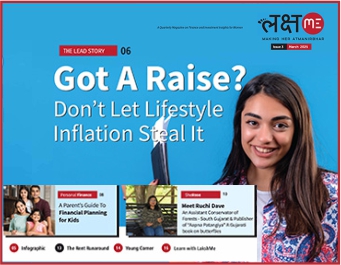What is Asset Allocation?
As a budding investor, the primary goal is to buy suitable investment products. However, buying the right products alone might not make you a good investor. You have to build an investment portfolio for yourself where there should be an ideal balance of risk and return.
Asset Allocation is the strategy that helps you understand and balance the risk and return across your assets. While diversification is an essential aspect of asset allocation, it is way more than not putting all your eggs in one basket. Let's understand it in detail.
What is Asset Allocation?
Investing in multiple financial asset classes, such as mutual funds, property, fixed deposits, gold, PPFs and stocks etc., are ways of diversifying your portfolio. These assets vary in risk as well as return depending on the market conditions and some other variables. The strategies that you, as an investor, or a portfolio manager, apply to balance out the risk and return are known as asset allocation. Throughout your investment period, you may use one or different types of asset allocation strategies to achieve your financial goals. Let us take a look:
Strategic Asset Allocation
Strategic asset allocation is a long-term strategy which is similar to buying and holding. While enforcing discipline to your investments, it also gives you time to patiently make your, investment decisions. There are two different approaches that you can apply in strategic asset allocation, age-based and risk profile based.
Example- You are 30 years old, so based on the recommended equity asset calculation, we subtract 30 from 100. Thus, 70% of the investment in your portfolio should be in equity.
While age-based investment strategies are indeed a good way to start your investment journey, they wouldn’t always be sufficient. Depending on the risk-taking capacity, an investor may be classified into three broad categories:
Aggressive: Generally more experienced, such investors know how the market works and, thus, can take more significant risks.
Moderate: Such investors are more risk-tolerant as compared to conservative investors and do not mind taking a few risks. They mostly have a more balanced approach and follow a fixed percentage of loss they can handle.
Conservative: Conservative investors are the ones who like to take the least risk and prefer having limited-return options, for example, FDs, postal schemes, PPF etc.
Tactical Asset Allocation
Many investors consider strategic asset allocation to be rather rigid. As the market conditions keep fluctuating, it often brings more opportunities to get good returns which might not be possible in the case of a more strategic approach. Tactical asset allocation, on the other hand, allows you to be a little more flexible and thus deviate from a long-term allocation.
Let's build up on the same example. As per your Strategic asset allocation, you have invested about 70% in equity and 30% in debt. However, gradually you feel that equities are giving better returns, so you add 10% of an extra allocation to equities taking the mix to 80%-20%. You may eventually choose to stick to your strategic asset allocation, but this is a tactical call that can be taken, wherein this momentum may often help boost your short-term returns.
Dynamic Asset Allocation
In case you wish to be a more “living in the moment” kind of investor, you may want to increase your equity allocation when the market rises and reduce it when you see a fall. More well-suited for an aggressive investor, when you have a dynamic asset allocation, you continuously make adjustments in your asset allocation. Thus, your portfolio is nearly as close as your ideal asset allocation in all market conditions.
Depending hugely on the market conditions, other factors such as the well-being of the economy, the state of a specific sector etc., play a key role in the allocation. Proponents feel that investors hold up a high-performing asset that is enough to manage risk, whereas critics believe that such strategies are far more labour-intensive.
Risk profile questionnaire
Understanding the styles of investments and the ever-evolving strategies can often become overwhelming, especially for a budding investor. In such a position, a risk profile questionnaire will be beneficial in reflecting on your own situation.
Designed to gain an in-depth insight into your financial goals and objectives, the ideal questionnaire will serve as a foundation for a robust portfolio. The risk profile questionnaire will include components such as investment objectives and your appetite for risk.
Steps to achieve ideal Asset Allocation-
With an asset allocation plan in place, you will be able to sidestep making ad-hoc judgments. Here are some steps and tips that you can use when allocating assets.
1. Set your goals before you set out:
Your asset allocation has to be based on your investment objectives. You also need to keep in mind your ongoing financial situation, your appetite for risk, and the time you plan to invest.
Example: The asset allocation for a goal that is 20 years away will certainly be different from the goal of generation of capital that you wish to do in 5 years.
2. Diversification:
Picking the right group of investment products will help you reduce the risk and the fluctuation in returns.
3. Avoid juggling too much:
While it can be quite tempting to fall for a more profitable scenario, too much juggling in the short term will not just be costly but may also prove to be futile in the long run.
4. Bare in mind the taxation:
With the RBI tweaking the repo rates now and then, it is important that you factor in taxation, especially in the case of short-term goals.
5. Keep an eye on the allocation:
Regular monitoring and adjustments in the strategies is a vital aspects. Portfolio rebalancing should match the investment goals you have set for yourself.
Conclusion
Asset Allocation may seem to be overwhelming and complicated. However, with clear goals and the right approach, you will be able to understand the strategy that would suit you the best. You can further take help from financial advisors and make better and more informed decisions.
Do you have any questions? Write to us






















